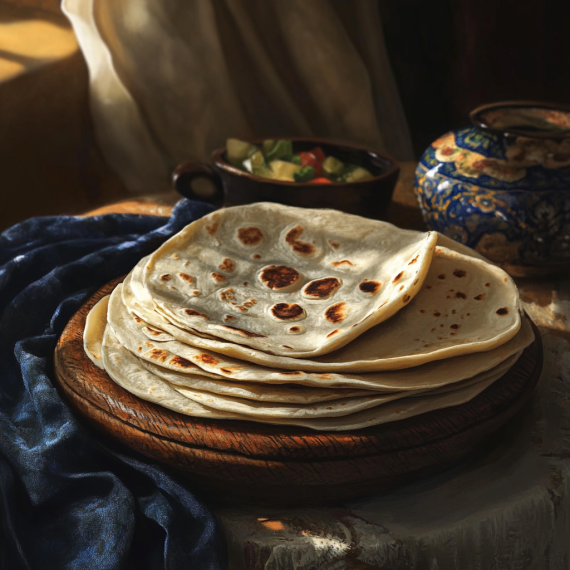Homemade Flour Tortillas are a simple yet delicious treat that elevate any meal. With just a few basic ingredients—flour, butter, salt, and baking powder—you can create soft, warm tortillas that taste far better than store-bought versions. Whether you’re making tacos, wraps, or quesadillas, these tortillas add the perfect touch. The process is easy, and the results are irresistibly good. In this post, we’ll show you how to master the art of making Homemade Flour Tortillas, along with tips for soft, fluffy results every time. Get ready to enjoy tortillas fresh from your kitchen.
Essential Ingredients for Perfect Homemade Flour Tortillas
All-Purpose Flour vs. Masa Harina
When making Homemade Flour Tortillas, all-purpose flour is the best choice. It’s versatile, widely available, and creates soft, flexible tortillas. This flour has a neutral flavor, allowing your fillings to shine. It’s perfect for achieving the ideal texture in flour tortillas.
On the other hand, masa harina is made from ground corn and used to make corn tortillas. It has a distinct flavor and texture that’s different from all-purpose flour. Masa harina requires a different approach, as it needs to be mixed with water and sometimes fat to form the dough. While both types of flour are used in Mexican cuisine, masa harina is not suitable for flour tortillas. Stick with all-purpose flour for the best results when making soft, delicious Homemade Tortillas.
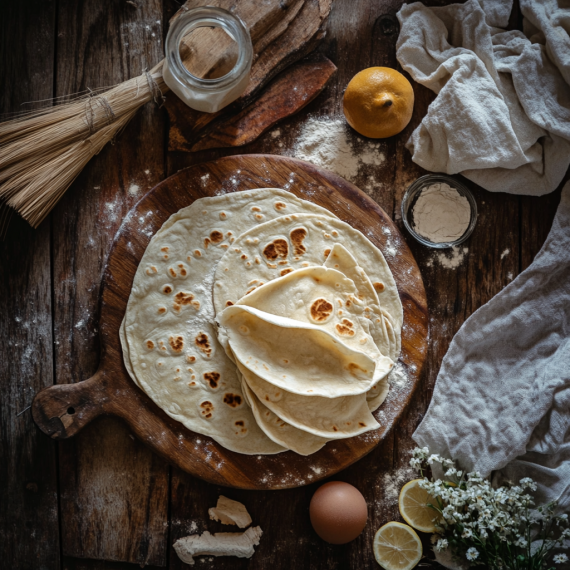
The Role of Baking Powder and Salt
Baking powder plays a crucial role in making soft, airy Homemade Flour Tortillas. It helps the dough rise slightly while cooking, creating a light, fluffy texture. Without it, the tortillas would be dense and tough. The small amount used in the recipe ensures that the tortillas are not overly puffy, but just soft enough to be flexible.
Salt enhances the flavor of the tortillas, balancing the sweetness of the flour. It also helps control the dough’s texture, making it easier to work with. Without salt, the tortillas would taste flat and bland.
Together, baking powder and salt create the perfect balance for tortillas that are soft, flavorful, and easy to fold. They’re essential for achieving the ideal texture and taste in every bite.
Butter or Oil in Homemade Flour Tortillas
Both butter and oil are used to add richness and moisture to Homemade Flour tortillas. The choice between the two depends on the texture and flavor you prefer. Butter gives tortillas a slightly richer, more tender texture and a delicious, buttery flavor. It creates a slightly flaky result, which some people prefer for its lightness.
Oil, on the other hand, is a more neutral option. It makes the tortillas soft and flexible, with a more subtle flavor. Vegetable oil or olive oil can be used, depending on your taste. Oil also helps prevent the tortillas from drying out as quickly.
Both options work well, so the decision often comes down to personal preference. If you want a richer, more indulgent flavor, butter is the way to go. If you prefer a softer, more neutral-tasting tortilla, oil will do the trick.
Step-by-Step Guide to Making Homemade Flour Tortillas
Mixing the Dough
Mixing the dough for Homemade Flour Tortillas is a simple yet important step. Start by combining the dry ingredients: all-purpose flour, baking powder, and salt. Whisk them together to ensure even distribution of the ingredients. Next, add the butter or oil to the dry mixture. Use your fingers or a pastry cutter to incorporate the fat until the mixture resembles coarse crumbs.
Gradually add warm water to the mixture, a little at a time. Stir with a spoon until the dough begins to come together. At this point, switch to your hands. Knead the dough in the bowl for a few minutes, ensuring it’s smooth and slightly elastic. If the dough feels too dry, add more water, one tablespoon at a time. If it’s too sticky, add a little more flour. Properly mixed dough will result in soft, pliable tortillas.
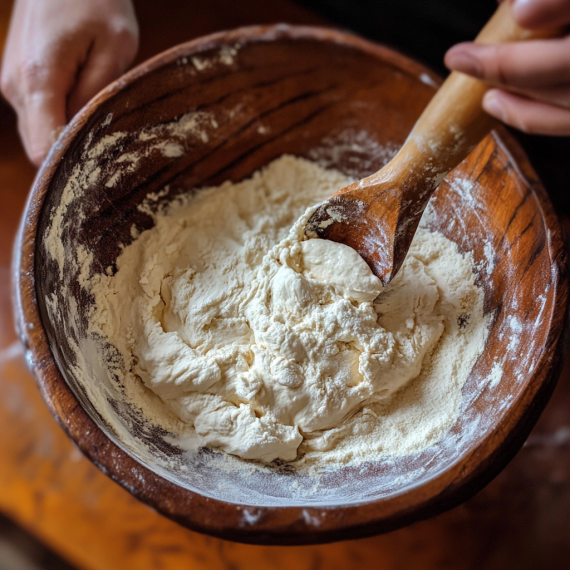
Kneading the Dough
Kneading the dough is a key step to achieve soft, smooth tortillas. Once you’ve mixed the ingredients, transfer the dough to a lightly floured surface. Begin kneading by folding the dough over itself and pushing it down with the palms of your hands. Rotate the dough a quarter turn with each fold to ensure even kneading.
Knead for about 5 to 7 minutes. You want the dough to become soft, smooth, and slightly elastic. If the dough is too sticky, sprinkle a little more flour on the surface, but avoid over-flouring, as this can make the tortillas tough. If the dough feels too dry, add a small amount of water.
Proper kneading helps activate the gluten in the flour, giving the tortillas their chewy texture. Once the dough is ready, form it into a ball and cover it to rest before rolling out. This resting period helps relax the dough.
Resting the Dough
Resting the dough is a crucial step when making Homemade Flour Tortillas. After kneading, cover the dough with a clean kitchen towel or plastic wrap. Let it rest for at least 20 to 30 minutes. This resting time allows the gluten to relax, making the dough easier to roll out. It also helps the tortillas become softer and more pliable.
During the resting period, the dough absorbs the moisture evenly, preventing any dryness or cracking when rolled. If you’re short on time, a 15-minute rest can still yield good results, but longer resting will improve texture.
Don’t skip this step, as it ensures that the dough remains manageable and smooth. Once rested, the dough will be easier to divide into small portions and roll out into perfect tortilla circles. This simple step contributes to achieving the ideal soft, flexible texture in your tortillas.
Tips and Tricks for Soft, Fluffy Homemade Flour Tortillas
Use a Rolling Pin for Even Thickness
Using a rolling pin is essential for achieving evenly shaped, uniform tortillas. After resting the dough, divide it into small, equal-sized balls. Lightly flour your surface to prevent sticking. Place one dough ball in the center and begin rolling it out with the pin.
Apply even pressure as you roll, working from the center outwards. Rotate the dough occasionally to maintain a circular shape. The goal is to roll the dough as thin as possible without tearing it. Aim for tortillas that are about 6 to 8 inches in diameter, but feel free to adjust depending on your preference.
Using a rolling pin ensures an even thickness throughout, which helps the tortillas cook uniformly. Unevenly rolled dough may result in some parts being overcooked while others remain undercooked. For best results, roll slowly and steadily for consistent thickness and a perfect tortilla every time.
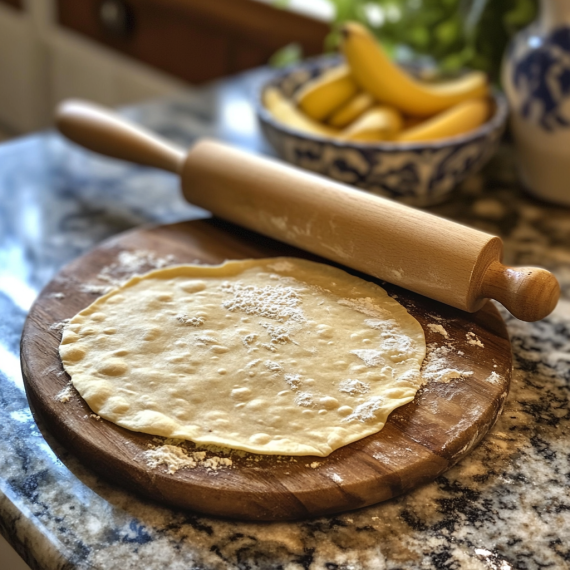
Cooking Homemade Flour Tortillas on a Hot Skillet or Griddle
Cooking your Homemade Flour Tortillas on a hot skillet or griddle is key to achieving that perfect golden brown color and soft texture. Preheat a cast-iron skillet or a flat griddle over medium-high heat. Make sure the surface is hot before placing the tortilla on it. You can test the heat by sprinkling a few drops of water on the skillet—if they sizzle, it’s ready.
Place the rolled-out dough onto the hot surface. Don’t add oil or butter to the skillet. Let the tortilla cook for about 30 seconds or until small bubbles begin to form. Flip it using tongs or a spatula, and cook the other side for another 30 seconds.
The tortilla should puff up slightly as it cooks. This is a sign of a well-cooked, soft tortilla. Keep an eye on it to prevent overcooking, which can make it dry.
The Tortilla Press Option
Using a tortilla press is a convenient option for making uniformly shaped tortillas with minimal effort. It’s a simple kitchen tool that presses the dough into a flat, even circle. A tortilla press can save time and ensure that each tortilla has the same thickness.
To use the press, place a dough ball between two sheets of parchment paper or plastic wrap. Then, press down firmly using the handle. With just a few presses, you’ll have a perfectly shaped tortilla, ready to cook.
While a tortilla press is not essential, it can be helpful for beginners or those making large batches. It eliminates the need for a rolling pin and ensures consistency in size and thickness. For best results, choose a heavy, well-made press, usually cast iron or aluminum, for even pressure and durability.
Creative Ways to Serve Homemade Flour Tortillas
Tacos with Homemade Flour Tortillas
Tacos are one of the most popular ways to enjoy Homemade Flour Tortillas. The soft, warm tortillas serve as the perfect base for a variety of fillings. Whether you prefer grilled chicken, beef, or vegetarian options, the possibilities are endless.
Start by warming your tortillas on the skillet or griddle until slightly charred. Then, layer your taco with your choice of protein or veggies. Add toppings like guacamole, salsa, cheese, or cilantro for added flavor. A squeeze of lime can brighten up the taste even more.
Homemade Flour Tortillas bring a fresh, authentic touch to your tacos that store-bought versions just can’t match. The flexibility and softness of freshly made tortillas make them perfect for wrapping around your fillings without falling apart. Whether it’s for a casual weeknight dinner or a festive gathering, Homemade Tacos will always impress.
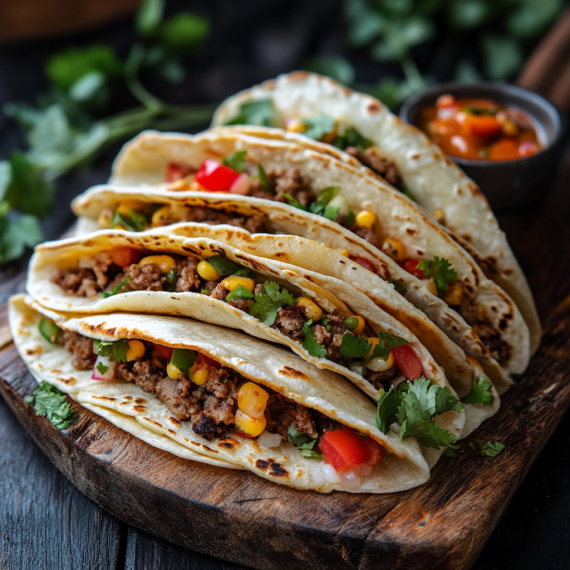
Wraps with Homemade Flour Tortillas
Homemade Flour Tortillas are perfect for creating delicious wraps. Their soft and flexible texture makes them ideal for wrapping around a variety of fillings. Start with your favorite protein, such as grilled chicken, turkey, or roast beef. Add in fresh vegetables like lettuce, tomatoes, and avocado for a crunchy contrast.
You can also add spreads like hummus or cream cheese for extra flavor. Don’t forget your seasonings! A pinch of salt, pepper, and perhaps some hot sauce can really elevate the taste.
Wraps made with homemade tortillas offer a fresh, healthy alternative to store-bought versions. They’re also more customizable, allowing you to experiment with different fillings. Whether for lunch or dinner, these wraps are quick, satisfying, and versatile. Homemade Flour Tortillas add a personal touch that enhances the flavor and texture, making your wraps stand out.
Quesadillas and More with Homemade Flour Tortillas
Homemade Flour Tortillas are the perfect base for delicious quesadillas. Simply place a tortilla on a hot skillet, sprinkle with cheese, and add other fillings like chicken, beans, or spinach. Top with another tortilla and cook until both sides are golden and crispy. The result is a melty, savory treat that’s perfect for lunch or dinner.
You can also use homemade tortillas for burritos, wraps, or even breakfast burritos. Fill them with scrambled eggs, cheese, and your choice of meat or veggies for a satisfying meal.
Another great option is to turn your tortillas into chips. Cut them into triangles, fry or bake them, and serve with salsa, guacamole, or cheese dip. Homemade Flour Tortillas offer endless possibilities in the kitchen, making them a versatile addition to any meal.
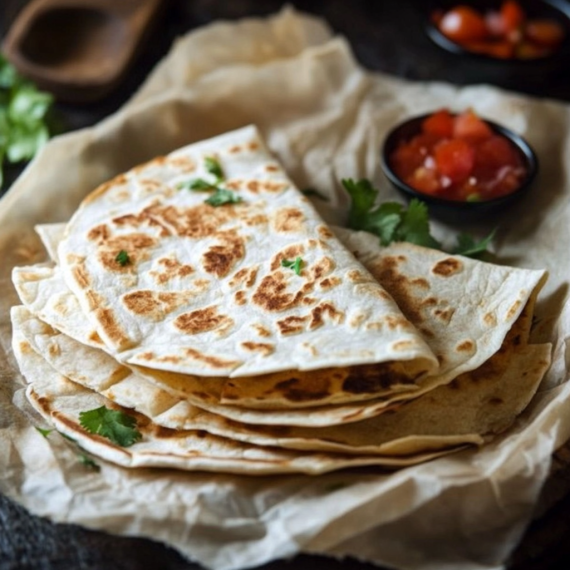
Troubleshooting Common Homemade Flour Tortillas Issues
Tough or Dry Tortillas
If your tortillas turn out tough or dry, there are a few common causes. First, overworking the dough can make the tortillas dense. Knead the dough just until it’s smooth, but don’t overdo it. If you knead too much, it can make the dough tough.
Another reason for dry tortillas is insufficient moisture in the dough. Ensure that you add enough water to create a soft, pliable dough. If the dough feels dry, add a little more water, one tablespoon at a time.
Finally, overcooking the tortillas can lead to dryness. If you leave them on the skillet for too long, they’ll lose moisture and become hard. Cook them just until small bubbles form, then flip them. Keep an eye on the cooking time to avoid drying out your Homemade Flour Tortillas.
Sticky Dough
If your dough is too sticky, it can be challenging to work with. This usually happens when there’s too much water in the dough. To fix this, add a little flour at a time while kneading until the dough reaches the right consistency. Be cautious, though—adding too much flour can make the dough tough.
Another reason for sticky dough is not kneading long enough. Kneading helps distribute the moisture evenly, which can help reduce stickiness. If the dough is still sticky after kneading, let it rest for 10-15 minutes. This resting time allows the dough to absorb the moisture properly, making it easier to handle.
It’s also important to flour your surface and hands when rolling out the dough. This prevents it from sticking and allows you to roll out even, thin Homemade Flour Tortillas.
Uneven Cooking
Uneven cooking can occur when the skillet or griddle is not hot enough or too hot. To avoid this, preheat your cooking surface properly before adding the tortilla. A medium-high heat works best to cook the tortillas evenly.
Another cause of uneven cooking is uneven dough thickness. If the dough is rolled out too thick in some areas, it won’t cook uniformly. Using a rolling pin ensures a consistent thickness for better results.
It’s also important to flip the tortillas at the right time. If you wait too long to flip, one side may burn while the other remains undercooked. Watch for small bubbles to form, which indicates it’s time to turn the tortilla.
Finally, make sure to rotate the tortilla slightly after flipping. This helps ensure both sides cook evenly, resulting in a perfectly golden, soft tortilla every time.
Conclusion
Making Homemade Flour Tortillas is a rewarding and simple process. With the right ingredients, tools, and techniques, you can achieve soft, flavorful tortillas that elevate any meal. Whether you’re making tacos, wraps, or quesadillas, homemade tortillas add a personal touch to your dishes.
Remember to knead the dough well, let it rest, and cook on a hot skillet for the best results. With practice, you’ll master the art of Homemade Flour Tortillas and enjoy them fresh from your kitchen every time.

